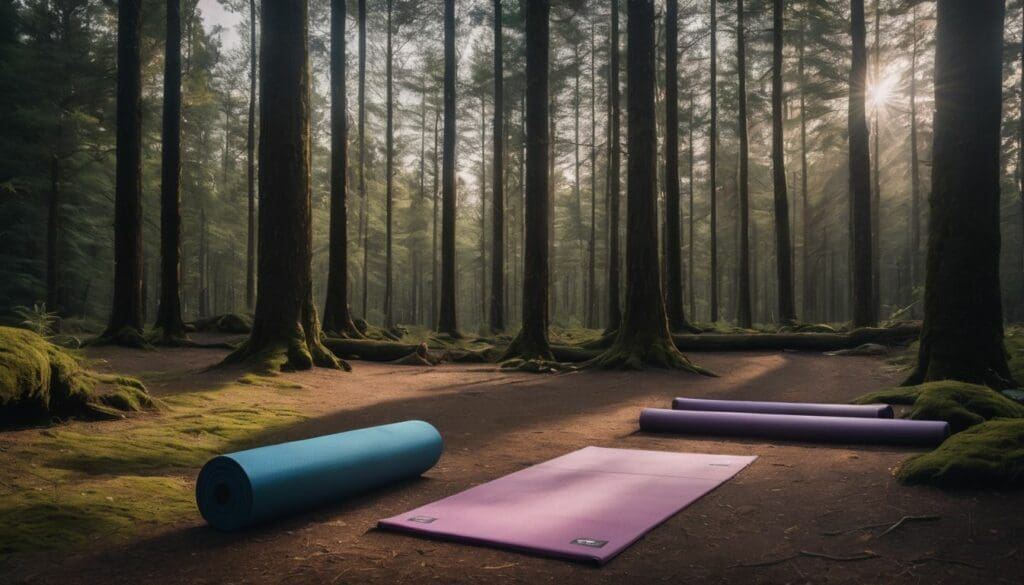Feeling stiff and sluggish can start to cramp your style, especially as we spend more time sitting down. Stretching regularly is key; in fact, it can increase flexibility by up to 35% after just eight weeks of consistent practice.
Our guide offers simple stretching exercises that will loosen you up and enhance your range of motion with ease. Get ready to bend without the snap!
Key Takeaways
- Stretching consistently can boost flexibility by up to 35% within eight weeks, helping you move more freely and with less discomfort.
- Incorporating various types of stretching, like static, dynamic, and PNF stretches into your exercise routine supports improved joint range of motion and muscle health.
- Simple exercises such as forward lunges, seated straddle lotus, cobra pose, and reclining bound angle pose enhance lower body strength and upper body elasticity.
- Regular stretching routines lead to numerous benefits including better posture, reduced muscle tension, increased circulation which is essential for a healthier lifestyle.
- Stretching is not just beneficial for athletes but also for those leading sedentary lifestyles or spend long periods sitting — it helps mitigate potential strains and muscle damage.
Why Stretching is Important for Flexibility
Stretching is crucial for flexibility as it helps to improve the range of motion in your joints, allowing you to move more freely. It also has various benefits such as reducing muscle tension and increasing circulation.
Benefits of stretching
Regular stretching keeps your muscles flexible, strong, and healthy. Flexibility is crucial for maintaining a range of motion in your joints. Without it, muscles shorten and become tight.
Then, when you call on the muscles for activity, they are weak and unable to extend all the way. That puts you at risk for joint pain, strains, and muscle damage.
Starting your day with a morning stretch routine can energise your body and get blood flowing. It also promotes better posture by loosening up tight muscles that result from prolonged sitting or environmental stressors.
For athletes or fitness enthusiasts, engaging in full-body stretches preps their body for workouts ahead, making them less prone to injuries. Moreover, incorporating flexibility training into your daily regimen helps reduce stress levels as stretching also has a calming effect on the mind as well as boosting circulation which aids in quicker recovery post-exercise.
How it improves range of motion
Improved range of motion allows for easier movement during daily activities and exercise, reducing the risk of injury. Regular stretching helps to lengthen muscles and tendons, which increases flexibility in joints such as the hips, shoulders, and knees.
This enhanced flexibility enables a wider range of motion, making it easier to bend, reach, twist and turn without discomfort or strain on the body.
Enhanced range of motion also contributes to better posture and alignment. This can alleviate stiffness in muscles and mitigate joint pain while promoting ease of movement throughout the day.
Types of Stretching
Static stretching, dynamic stretching, and proprioceptive neuromuscular facilitation (PNF) stretching are the three main types of stretching. Each type has its own benefits and is effective for improving flexibility and range of motion in different ways.
Static stretching
Static stretching involves holding a single position for an extended time to target a specific muscle group and gradually increase its flexibility. This type of stretching is ideal for improving overall flexibility, which in turn reduces the risk of injury during physical activities.
Incorporating static stretches into your routine can help improve your range of motion and provide relief from muscle tightness and tension. It’s also an excellent way to wind down after physical activity or as part of a morning stretching routine.
When practicing static stretches, it is important to focus on proper breathing techniques and aim for gentle and sustained movements rather than quick, jerky motions. This approach helps elongate the muscles safely without causing strain or damage.
Dynamic stretching
Transitioning from static stretching to dynamic stretching, this type of stretching involves continuous movement through a full range of motion. Dynamic stretching helps improve flexibility, increases blood flow and oxygen to muscles, and can even prepare the body for physical activity.
This kind of stretching is great for athletes and those looking to enhance their overall range of motion.
Engage in dynamic movements such as leg swings, arm circles, or walking lunges to promote flexibility throughout your body. These exercises are beneficial for warming up the muscles and preparing them for more intense physical activity or workouts.
Proprioceptive neuromuscular facilitation (PNF) stretching
Proprioceptive neuromuscular facilitation (PNF) stretching increases flexibility by engaging the muscles to relax and contract. This type of stretching involves a partner or resistance, promoting improved range of motion and muscle strength.
PNF stretching is beneficial for athletes, beginners, and those seeking to enhance their overall flexibility.
By incorporating PNF stretching into your routine, you can gradually improve your body’s mobility and resilience. The technique encourages muscles to adapt to increased flexibility over time, contributing to better overall body conditioning.
Basic Stretching Exercises
Increase your flexibility with simple stretching exercises like forward lunges, side lunges, and seated straddle lotus. These basic stretches can help improve your range of motion and are perfect for beginners.
Forward lunge
Perform the forward lunge by stepping one leg in front of you and lowering your hips until both knees are bent at a 90-degree angle. Keep your back straight and engage your core for stability.
Press through the heel of your front foot to return to the starting position. This exercise helps improve lower body flexibility and strengthens the quadriceps, hamstrings, and glutes.
Enhance flexibility with this simple beginner stretch, promoting a full-body stretching routine while increasing range of motion in environmentally conscious individuals supporting conservation efforts.
Side lunge
Transitioning from the forward lunge, the side lunge targets different muscle groups while also improving lower body flexibility. To perform a side lunge, take a wide step to the right, keeping your left leg straight and bending your right knee while lowering your hips towards the ground.
Push back up to standing position using your right heel and return to starting position before repeating on the other side. This exercise stretches the inner thighs and groin muscles while also engaging the quadriceps and glutes.
Maintaining regular practice of side lunges will aid in improving overall lower body flexibility, making it an ideal addition to any full-body stretching routine. Additionally, athletes looking for gentle yet effective mobility exercises can incorporate this simple stretching technique into their workout regimen for enhanced range of motion in their hips and legs.
Cross-over stretch
To do the cross-over stretch, lie on your back with arms out to the sides. Lift your right leg and cross it over your body, aiming for the left hand. Hold the stretch for 15-30 seconds then switch sides.
This exercise is beneficial for increasing flexibility in the lower back, hips, and glutes.
Addressing environmental concerns requires a healthy and flexible body to keep up with sustainable practices. Include this simple stretch in your routine to maintain flexibility and range of motion as you support conservation efforts.
Seated straddle lotus
Sit on the floor with your legs extended in a V-shape, then bend one knee and bring the sole of your foot to rest against the inner thigh of the opposite leg, repeating with the other leg.
Keep your back straight and gently lean forward from your hips. Hold this position for 15-30 seconds, feeling a stretch along the inner thighs and lower back.
This exercise can help improve flexibility in your hips and groin area, promoting better range of motion and reducing muscle tension. It’s an excellent addition to any stretching routine aimed at enhancing overall flexibility and maintaining a healthy body.
Seated side straddle
Sit on the floor with your legs extended wide apart, keeping your back straight. Slowly lean to one side, reaching towards your toes while keeping both hips grounded. Hold the stretch for 15-30 seconds, feeling the gentle pull along the inner thighs and hamstrings.
Then, switch to the other side and repeat.
Maintain steady breathing throughout this stretch to help relax and lengthen the muscles. The seated side straddle is an effective way to increase flexibility in the groin area and improve overall lower body range of motion.
Knees to chest stretch
Lie on your back with your legs extended. Draw one knee towards your chest, clasping your hands behind the thigh. Hold for 20-30 seconds and then switch legs. This stretch helps release tension in the lower back and increases flexibility in the hips and lower spine.
To deepen the stretch, flex the foot of the raised leg while keeping it off the floor. Feel a gentle pull through the back of your leg and into your glutes and lower back, maintaining steady breathing throughout.
Arm, Back, and Hip Stretches
Try incorporating stretches such as the Cobra pose, Doorway pectoral stretch, and Lunge hip flexor stretch to improve flexibility in your arms, back, and hips. To learn more about these simple stretching exercises for flexibility, keep reading!
Cobra pose
Engage your core and stretch the front of your body with the Cobra pose. Lie on your stomach, placing your hands under your shoulders. As you inhale, lift your chest off the ground while keeping your lower body grounded.
This gentle backbend helps to improve flexibility in the spine and opens up the chest and shoulders.
The Cobra pose also strengthens the muscles along the spine and can help alleviate stress and fatigue. Hold this pose for a few breaths, feeling a gentle stretch in the abdomen, chest, and low back.
Doorway pectoral stretch
Transitioning from the back and arm stretches, let’s move on to the doorway pectoral stretch. This simple yet effective exercise targets the chest and shoulders, promoting flexibility in these areas.
To perform this stretch, stand in a doorway with your arms bent at 90-degree angles and forearms resting against the doorframe. Gently lean forward until you feel a comfortable stretch across your chest and shoulders.
Hold this position for 15-30 seconds while breathing deeply. This stretch is perfect for individuals seeking to improve upper body flexibility while also providing relief from tightness accumulated during long periods of sitting or hunching over electronic devices.
Child’s pose
In child’s pose, sit back on your heels and stretch your arms forward, lowering your chest towards the ground. This gentle stretch is perfect for releasing tension in the lower back and hips.
Breathe deeply into the pose to promote relaxation while improving flexibility in the spine, shoulders, and neck. Child’s pose is an effective way to start or end a stretching routine and can be modified by using a cushion under your forehead for added comfort.
Lunge hip flexor stretch
To do the lunge hip flexor stretch, start in a standing position with your feet shoulder-width apart. Take a step forward with your right leg and lower your body into a lunge, bending both knees at 90-degree angles.
Keep your upper body straight and engage your core muscles. Slowly shift your weight forward until you feel a gentle stretch in the front of your left hip. Hold this position for 20-30 seconds, then return to the starting position and switch to the other leg.
This exercise helps improve flexibility in the hips and thighs, enhancing overall mobility and range of motion. It is especially beneficial for individuals who spend long hours sitting or have tight hip flexors due to prolonged periods of inactivity.
Reclining bound angle pose
Transitioning from the focused Lunge hip flexor stretch, we move to the Reclining bound angle pose. It is an effective yoga exercise that supports flexibility in the inner thighs and hips.
While lying on your back, bring the soles of your feet together and allow your knees to open out to the sides. This gentle movement helps release tension in the groin area and enhances overall flexibility in a calming, restorative manner.
Practising this pose regularly aids athletes and novices alike towards achieving improved lower body strength and range of motion without exertion or stress. The Reclining bound angle pose can be seamlessly incorporated into daily stretching routines for its accessibility and ability to encourage full-body relaxation.
Seated IT band stretch
Sit on the floor with your legs stretched out in front of you. Cross one leg over the other, placing the foot flat on the floor beside the opposite thigh. With a straight back, twist towards the crossed leg and place your elbow against your knee for support.
Hold this position for 15-30 seconds, then switch to stretch the other side.
This seated IT band stretch targets the iliotibial (IT) band, helping to improve flexibility and reduce tightness in the outer thigh and hip area. This can be particularly beneficial for athletes or individuals who engage in activities that place strain on these areas.
Conclusion
In conclusion, incorporating simple stretching exercises into your routine can significantly improve flexibility. These exercises are accessible to beginners and can be done at home without any special equipment.
Implementing a regular stretching routine will help in enhancing your range of motion and overall physical performance. Don’t overlook the incredible benefits that even a short stretching session can provide for your body and mind.
FAQs
1. What are simple stretching exercises for flexibility?
Simple stretching exercises for flexibility include beginner stretches that focus on improving your range of motion in both the upper and lower body through a full-body stretching routine.
2. Can anyone do these simple stretches, or are they only for athletes?
Anyone can perform these easy stretching techniques, whether you’re an athlete looking to enhance performance or a beginner seeking to increase flexibility and maintain healthy joints.
3. How often should I do morning stretches?
Incorporating morning stretches into your daily routine is a great way to start the day with energy and help maintain flexibility, aiming to stretch every morning for optimal benefits.
4. What kinds of stretches should I add for my lower body?
Lower body stretches typically target muscles in your legs and hips; including them in your stretching routine can improve overall leg movement and reduce stiffness.
5. Are there specific upper body stretches I should know about?
Yes, there are specific upper body stretches focusing on the arms, shoulders, chest and back that enhance flexibility and make everyday movements easier – perfect as part of any simple stretching routine.





